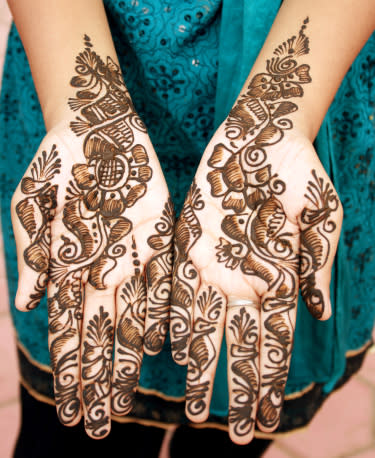Intricate henna patterns adorn Eid celebrations

In much of the Muslim world, henna (or mehndi) is a very important part of festivals and celebrations - particularly Eid Al Fitr, the three-day celebration that marks the end of Ramadan.
Women are apt to take centre stage at Eid - cooking, entertaining and spending time with friends and relatives coming from near and afar. As many do not use cosmetics during the month of Ramadan, Eid Al Fitr provides them with the perfect opportunity to beautify with kohl eyeliner, perfume and henna.
Henna paste is made from the leaves of ‘Lawsonia inermis’, a tall, shrub-like plant. In the Middle East and the subcontinent, the leaves are dried, ground into paste and blended with water to make the paste.
If the paste is made very fine, intricate designs can be created using cone-shaped tubes or syringes. Borders, swirls, floral patterns, zigzags and dots are very popular in the Middle East. In India and Pakistan, paisley patterns, lines and teardrops are intricately repeated to give the illusion of stockinged feet and gloved hands.
In some parts of the Middle East and Asia, women prefer simple blocks of colour on tips of fingers and toes. Women also like to create 'tattoos' with henna - they are painless and last longer than temporary tattoos.
Related: Traditional Eid decorations
There are many varieties of henna that leave different coloured imprints when applied, ranging from orange to deep red and even black. Chemicals are usually added to the paste to enhance its colour. The longer the paste is left on the skin, the richer the colour of the design. It is customary to dab the applied design with cotton wool dipped in sugar and lemon. This moistens the henna before it is removed, and prevents it from drying and chipping off before the design has had enough time to set.
In many Arab countries, beauty salons are fully booked in the days leading up to Eid, with many offering special Eid packages and rates. Women are permitted to pray wearing henna art; however, other man-made cosmetics, such as nail varnishes, should be removed.

Henna art has become almost as important as new clothes for Eid Al Fitr. In many cultures, women organise henna parties and invite henna artists to apply intricate designs on the palms of the female guests. Such parties are a time for women to share their plans for Eid Al Fitr, discuss recipes, and generally catch up on chit-chat. But in some countries, women meet at hammams (bath houses), where henna is part of an elaborate cleansing ritual. Women are scrubbed, bathed and massaged, before decorating their hands and feet with henna in preparation for Eid.
Related: Delightful Eid desserts from around the world
In the Gulf, most malls and public spaces set up special stalls where women can get instant henna applications; young girls who get money for Eidiya (their Eid present) often head for henna tents during Eid to refresh their henna patterns.
Henna is also used as a natural colouring alternative to harsh chemical hair dyes. Henna is usually applied to the whole head of hair, which is then covered with a disposable shower cap and wrapped with a towel to hold in heat and moisture, which helps the dye to activate. Many salons even offer henna for the hair as part of their services when they prepare Eid beauty packages.
Get more Ramadan news, watch videos and TV shows and send greeting cards to friends and family.

 Yahoo News
Yahoo News 
